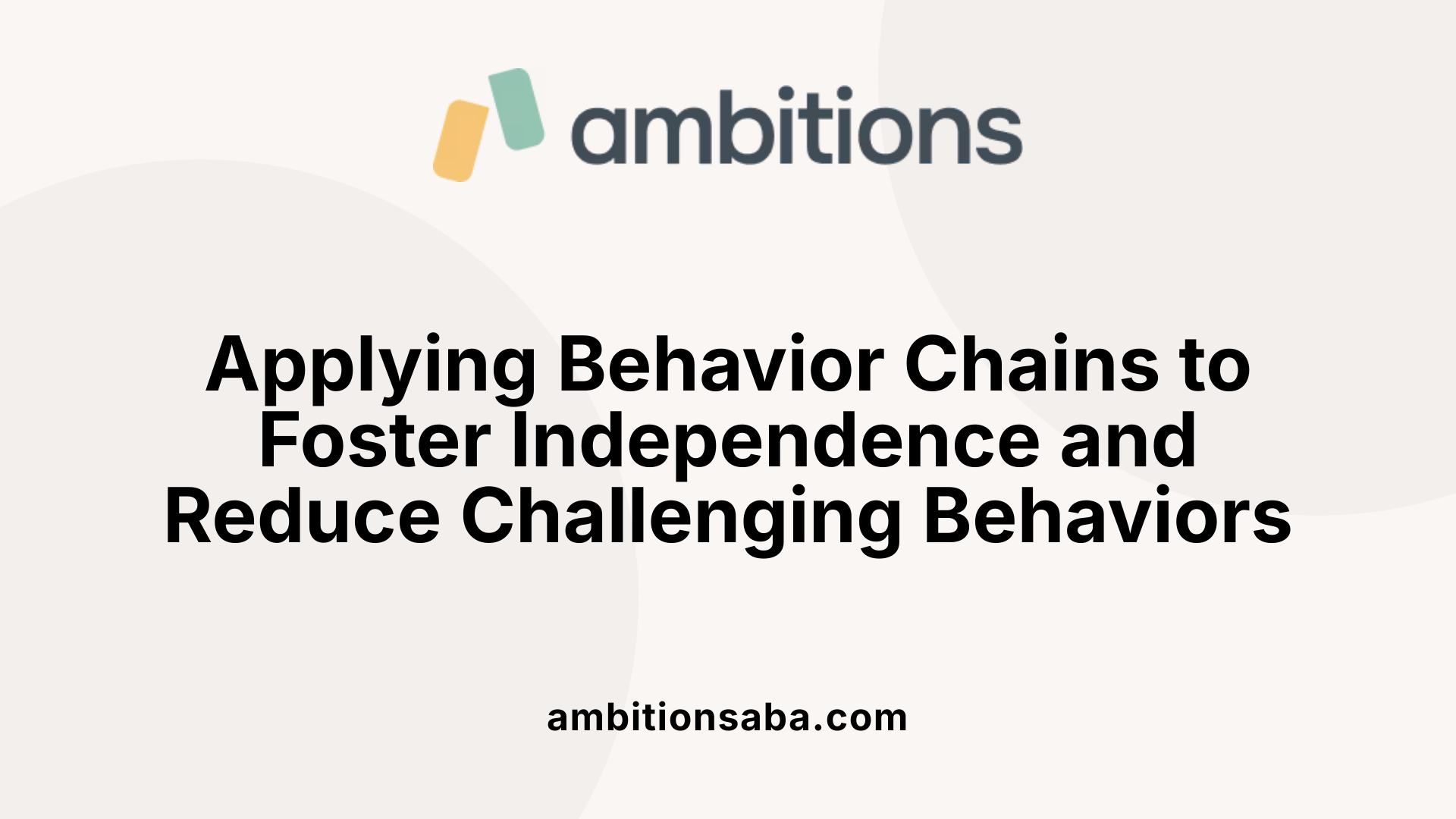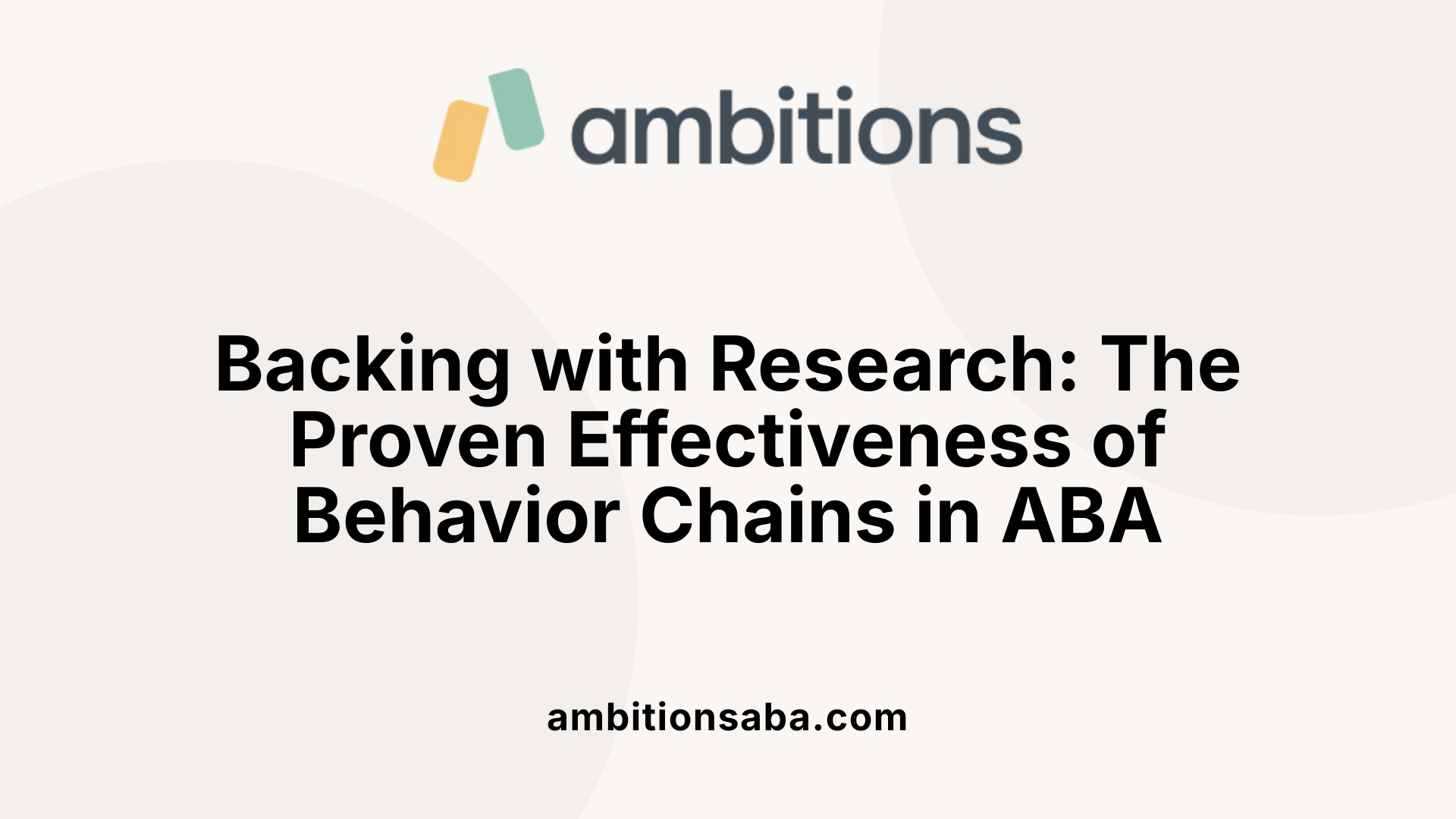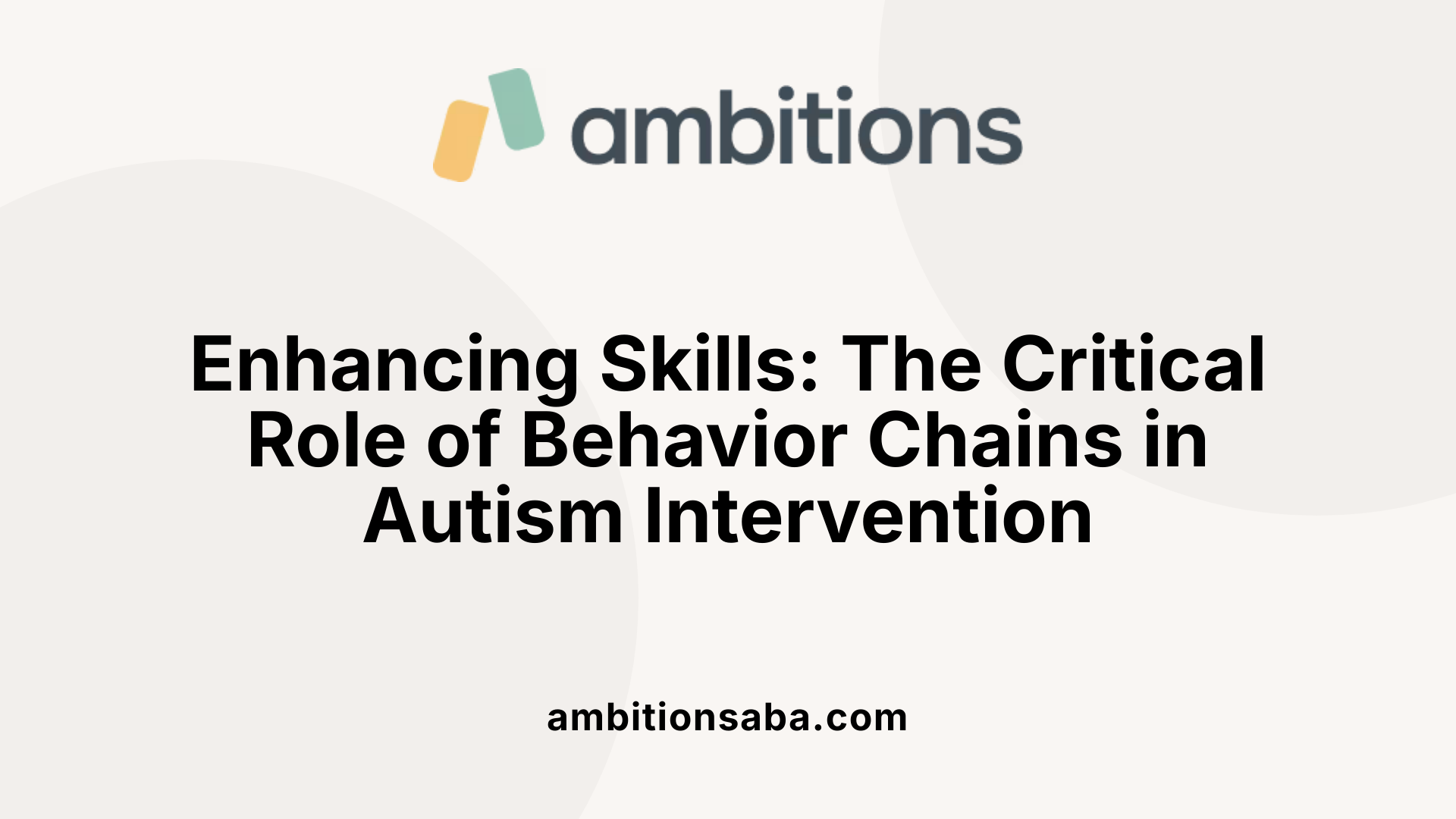Building Supportive Learning Environments to Foster Help-Seeking
Understanding the Foundation of Skill Development in ABA
Behavior chains are a cornerstone of Applied Behavior Analysis (ABA), providing a systematic approach to teaching complex skills, especially for individuals with autism. They are sequences of discrete responses linked together to achieve a broader, functional goal. This article explores what behavior chains are, how they are formed and structured, the methods used in their teaching, and their significant applications in behavioral interventions.
What Are Behavior Chains in ABA Therapy?
Definition of behavior chains
Behavior chains in ABA therapy are sequences of simple behaviors linked together to accomplish a complex skill or task. Think of them like a recipe, where each small step contributes to the final outcome. These chains are used to teach multi-step activities such as handwashing, dressing, or making a bed. Each individual response is both a part of the process and a cue for the next step.
Linkage of responses in a sequence
Responses in a behavior chain are organized sequentially, meaning that completing one behavior naturally cues the next. For example, putting on a t-shirt involves pulling the shirt over the head, buttoning it, and then perhaps tucking it in. Each step serves as a response to the previous one and a prompt for the next, creating a clear pathway to achieve the final goal.
Purpose of chaining in skill acquisition
Chaining aims to break down complex skills into smaller, manageable steps, making learning easier and more effective. It promotes independence by teaching individuals to perform routines without constant help. With systematic teaching, reinforcement, and prompt fading, chaining helps develop vital daily living skills, communication, and social behaviors. Overall, it offers a structured approach for skill development, especially beneficial for children with autism, by providing clear guidance and motivation at each stage.
How Are Behavior Chains Formed and Structured?

Role of task analysis
Behavior chains are created by first performing a process called task analysis. This involves breaking down a complex behavior or skill into smaller, clear, and manageable steps. For example, teaching a child to wash their hands would start with steps like turning on the faucet, wetting hands, applying soap, scrubbing, rinsing, turning off the faucet, and drying hands. Each step is defined so it can be taught systematically.
Breaking down complex behaviors
Breaking down behaviors makes it easier for learners, especially those with autism, to acquire new skills independently. By dividing tasks into simpler parts, educators can teach each component thoroughly before moving to the next. This stepwise approach reduces confusion, increases motivation, and helps ensure that skills are learned correctly. The process of dividing skills into steps is fundamental to behavioral chaining.
Sequence of behaviors and cues
Each step in a behavior chain serves as both a response to the previous action and a cue for the next. The steps are ordered in a specific sequence that makes logical sense and aligns with the natural flow of the task. Reinforcements, such as praise or rewards, are provided after the entire sequence or individual steps, which encourages repetition and mastery.
Different methods of chaining
There are three common types of chaining used in ABA based on how the steps are taught:
| Type of Chaining | Approach | Description | Suitable When |
|---|---|---|---|
| Forward Chaining | Teaching from the first step onward | The instructor teaches the initial step first, reinforcing the learner, then adds subsequent steps gradually. | The learner can perform most steps, but needs help with the initial actions. |
| Backward Chaining | Starting from the last step | Focuses on teaching the final step first, then works backwards through the sequence, often providing support for earlier steps. | The learner struggles with the last or later steps but can perform earlier ones. |
| Total Task Presentation | Teaching all steps at once | The learner is guided through the entire sequence with prompts; prompts are gradually withdrawn. | The learner can perform most steps with minimal support. |
How structure facilitates learning
Understanding how these components fit together helps educators identify where learners might face challenges in a behavior chain. Analyzing each step and the cues helps tailor interventions that reinforce correct performance at each point. This structure ultimately promotes independence and skill retention, as learners understand the whole process and are reinforced throughout.
Teaching Methods for Behavior Chains in ABA

What methods are used for teaching behavior chains in ABA?
In Applied Behavior Analysis (ABA), several effective methods are employed to teach complex skills through behavior chains. The three primary techniques are forward chaining, backward chaining, and total task presentation.
Forward chaining begins by teaching the first step of the sequence. Once the learner masters this part, the approach introduces the next step while reinforcing the initial one. This process continues sequentially until the entire chain is learned. It aligns well with natural task progression, encouraging confidence and understanding from the start.
Backward chaining takes a different approach by starting with the last step of the task. The learner practices completing the final step first, receiving reinforcement for success. Then, the instructor teaches the preceding step, gradually working backwards through the sequence. This method ensures the learner finishes each attempt with the entire action, which can enhance motivation and provide clear cues for success.
Total task presentation involves teaching all steps of the behavior chain during each teaching opportunity. Here, the learner is prompted through the entire sequence repeatedly, with prompts gradually faded as proficiency increases. This technique is suitable when the learner is capable of performing most of the steps with minimal assistance, promoting understanding of the entire activity.
Beyond these primary methods, ABA practitioners often incorporate prompting strategies and reinforcement to enhance learning. Prompting involves providing cues or assistance to guide the learner through the steps, while reinforcement consolidates the behavior, encouraging repetition.
Choosing the appropriate method depends on individual learner needs, the complexity of the task, and context. The goal is to foster independence, motivation, and the ability to perform multi-step behaviors effectively.
Application of Behavior Chains in Behavioral Interventions
 Behavior chains serve as a fundamental technique in behavioral interventions, especially in working with individuals with autism and other developmental challenges.
Behavior chains serve as a fundamental technique in behavioral interventions, especially in working with individuals with autism and other developmental challenges.
Teaching Daily Routines and Skills
One of the primary uses of behavior chains is to teach essential daily routines and self-care skills. For instance, skills such as handwashing, brushing teeth, or getting dressed are broken down into smaller steps using task analysis. These steps are then taught systematically via methods like forward chaining, where the first step is learned first, or backward chaining, which begins with the last step. This structured breakdown helps individuals learn complex activities more easily and gain independence.
Addressing Problem Behaviors
Behavior chain analysis (BCA) plays a crucial role in addressing problematic or disruptive behaviors. By examining where a learner struggles or refuses within a sequence, BCA identifies specific points that may trigger challenging behaviors. Interventions are then tailored to modify environmental cues, antecedents, or consequences, helping reduce problematic responses and promote appropriate behavior. For example, if a child refuses to enter a classroom, changing the entrance and teaching a new, manageable sequence can prevent tantrums.
Using Chaining to Promote Independence
Chaining techniques like total-task presentation can teach multiple-step skills simultaneously, reinforcing understanding of the entire activity. This approach is helpful when learners are ready to grasp all steps and can perform most of the task partially. Reinforcement is provided throughout the process to motivate learners, with gradual fading of prompts to foster independence.
In daily practice, behavior chaining is used across various settings—from homes and schools to vocational training—to enhance learning efficiency and generalization. Effective implementation involves identifying target behaviors, conducting detailed task analysis, choosing suitable chaining strategies, systematically teaching each step, and continuously monitoring progress. The structured nature of chaining not only builds essential skills but also boosts motivation and confidence, supporting overall behavioral and developmental growth.
| Aspect | Description | Example |
|---|---|---|
| Teaching daily routines | Breaking skills into steps and teaching them sequentially | Handwashing, dressing |
| Addressing behaviors | Analyzing points of difficulty to modify responses | Managing tantrums during transitions |
| Promoting independence | Using total tasks or modified chaining to foster self-sufficiency | Making beds, brushing teeth |
| Techniques involved | Forward, backward, total task | Tailored to learner readiness |
| Implementation steps | Target identification, task analysis, teaching, reinforcement | Systematic skill development |
Behavior chaining remains an evidence-based practice, supported by extensive research, and is essential in developing practical skills that lead to greater autonomy and improved quality of life.
Scientific Support for Behavior Chains in ABA
 Research provides strong evidence supporting the use of behavior chains within Applied Behavior Analysis (ABA). Numerous studies have demonstrated their effectiveness in teaching complex, multi-step skills vital for daily functioning, such as grooming, dressing, and vocational tasks.
Research provides strong evidence supporting the use of behavior chains within Applied Behavior Analysis (ABA). Numerous studies have demonstrated their effectiveness in teaching complex, multi-step skills vital for daily functioning, such as grooming, dressing, and vocational tasks.
Both forward and backward chaining methods have shown comparable success in promoting skill development. For example, research indicates that neither method significantly outperforms the other across different individuals, making both viable options depending on the learner's needs.
Behavior chains have proven particularly beneficial for individuals with autism and developmental disabilities. They help improve independence by breaking down tasks into manageable steps and providing structured reinforcement.
Experimental data from laboratory and real-world settings show that chaining techniques, including total task presentation, lead to greater skill acquisition compared to baseline conditions without prompts or supports. These findings highlight the practical value of behavior chains in diverse teaching environments.
Overall, scientific research affirms that behavior chaining is a versatile, effective tool for teaching essential life skills, fostering independence, and enhancing learning outcomes for individuals requiring structured instruction.
Role of Behavior Chains in Skill Acquisition for Individuals with Autism

What is the role of behavior chains in skill acquisition for individuals with autism?
Behavior chains serve as a fundamental method in helping individuals with autism develop complex, multi-step skills. By breaking down tasks into smaller parts through a process called task analysis, therapists can teach each step individually, making learning more manageable.
There are different approaches to teaching these chains, including forward chaining, backward chaining, and total task presentation. Forward chaining begins with the first step and progresses sequentially, reinforcing each step as it is completed. Backward chaining starts with the last step, working backwards, which often helps learners understand the complete sequence more quickly. Total task chaining involves teaching all steps at once, providing support as needed, and reinforcing the entire process.
Research supports the effectiveness of these procedures for children with autism. They are used to teach a wide range of skills—from daily routines like handwashing and dressing to vocational and communication skills. These strategies help promote independence by enabling learners to perform tasks without continuous assistance.
Implementing behavior chains involves specific steps: identifying the target skill, analyzing it into smaller steps, choosing a teaching method, systematically teaching each step, fading prompts over time, and providing reinforcement after successful completion.
The creation of tailored behavior chains not only improves the ability to perform essential daily functions but also fosters motivation and skill retention. This structured yet flexible approach helps ensure that skills develop in a meaningful, durable way.
In summary, behavior chains play a crucial role in teaching functional and life skills to individuals with autism. They support ongoing learning and enable individuals to navigate daily life more independently, ultimately contributing to their long-term growth and integration into various settings.
The Integral Role of Behavior Chains in ABA Success
Behavior chains are an essential component of ABA therapy, underpinning the development of complex, functional skills in individuals with autism. By breaking down skills into manageable steps through process like task analysis and utilizing effective teaching strategies like forward, backward, and total task chaining, therapists can promote independence, increase motivation, and ensure skill retention. Supported by robust research, behavior chaining continues to be a vital technique in enhancing daily living, communication, and vocational skills, ultimately contributing to better quality of life and greater societal integration for individuals with autism.
References
- Behavior Chaining - Applied Behavior Analysis Degrees
- What Is “Chaining” And How Is It Used In ABA Therapy?
- Mastering Skills with a Behavior Chain in ABA Teaching ...
- Behavior Chaining
- Behavior Chain
- What is Chaining in ABA Therapy? | Childwise
- Behavior Chaining - Applied Behavior Analysis Degrees
- Mastering Skills with a Behavior Chain in ABA Teaching ...
- What Is “Chaining” And How Is It Used In ABA Therapy?
- Behavior Chaining

